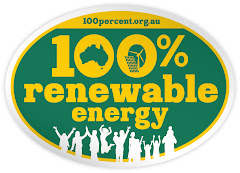Just under two weeks ago many of us at YCAN received a media release from Peter Batchelor, the Victorian Minister for Coal Industry Profits, trumpeting the recent Green Jobs Action Plan released in the State Budget on 4 May. As some environment groups had praised the plan, one of our members decided to investigate to see if the Brumby Government (as opposed to current form) had actually put forward a decent policy to tackle the climate crisis.
The State Budget announced several proposed water and energy efficiency measures. Most if not all of these initiatives are grouped under the heading ‘Jobs for the Future Economy - Victoria's Action Plan for Green Jobs’. Outside the ambit of the 'Jobs for the Future Economy' package Peter Batchelor proudly trumpets the hosting of the World Geothermal congress in 2015. Yes that's right a conference, in five years time.
The package allocates modest amounts to training and research but the proposed actions generally promote modest energy efficiency and water saving measures at the point of end use, the benefits of which are self-evident. These initiatives can be divided between limited term programs that last until the money runs out and a few driven by regulatory change and training programs that could be expected to have ongoing benefits. Modest but positive aspects of the package are the changes to landfill fees which seem likely to strengthen the recycling industry and the Green Door package from Planning Minister Madden which both tightens the climatic requirements of new housing and provides some training for builders relevant to the new regulatory regime. The rest however appears to be little more than pork barrelling. The total cost to government is projected to be $175 million and according to the Premier, “The program will achieve cost savings of more than $7 million per year through reduced energy and water consumption and save 130,000 tonnes of greenhouse gases each year”. Judging from the premier’s media release the package is projected to create ‘up to 700 (green) jobs’.
So how significant are these reductions in greenhouse gas emissions?
If we take the projected cost ($175 million) and divide it by the projected annual greenhouse gas emissions reduction (130,000 tonnes) we find the projected cost of mitigation is a staggering $1400/tonne.
If we compare the projected annual greenhouse gas emissions reduction (130,000 tonnes) to
So to summarise – the major climate change policy of the Brumby Government in the latest state budget will reduce
Another example from this material is the seductively named ‘Solar Hubs’ program under which the Brumby Government proposes to allocate $5 million for the establishment of up to 10 ‘solar hubs’ around regional
One petajoule = 277,778Mw-hr therefore annual domestic sector energy consumption, (164 petajoules) = 45,556,000 Mw-hr. The reduction in domestic energy demand resulting from the implementation of this program (1200Mw-hr) is miniscule. Given a projected annual rate of increase in domestic energy consumption of about 2.5% the solar hubs program would have to be multiplied by roughly 1000 to just cover the growth in energy demand! To follow this exercise in the absurd just one step further, just covering the projected annual increase in domestic (residential) energy consumption by expanding the Solar Hubs program would cost $5billion! These figures look incredible but we've checked several times.
The Brumby government is adopting a time-honored pre-election strategy of throwing money (as little as possible) at very carefully selected targets to give the misleading impression that they are addressing a problem that they think might impact on them electorally but which they have in reality chosen to avoid. Of course it can be argued that the primary intention of this package is the creation of environmentally responsible jobs. It is hard to judge whether $175 million spent on the creation of 'up to' 700 green jobs in regional Victoria is good value for money but as an exercise in emissions reduction (surely the primary measure of the 'green-ness' of a proposal) or as a demonstration of the government's ability to extract best value from green dollars invested, this package is very uneven.
In any case it is hard to take any policy seriously that proposes to reduce
Replacing Hazelwood Power Station with clean energy would reduce
A YCAN Investigation – State Government Green Jobs Package
Sunday, May 16, 2010
A YCAN Investigation – State Government Green Jobs Package
Subscribe to:
Post Comments (Atom)





1 comment:
The best information I have found exactly here. Keep going Thank you
new energy efficiency programs
Post a Comment